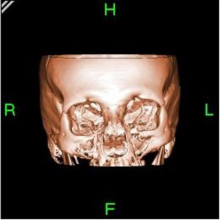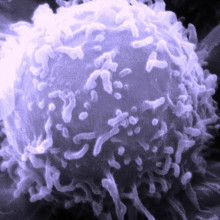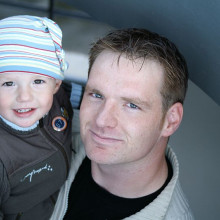Solving Scientific Problems with Computer Games
In this NewsFlash, we hear how computer gamers can help to solve scientific puzzles, why you not be as good as you think you are, and how the brain takes control of the immune system. Plus, how a new CT scanning facillity offers super-fast 3D x-ray vision!
In this episode

00:30 - Computers gamers solve protein puzzle
Computers gamers solve protein puzzle
Online computer gaming is sometimes viewed as a mere pastime without much outward benefit, but a new paper published today in the journal Nature Structural and Molecular Biology reveals how gamers playing an online game called Foldit have managed to crack the 3-dimensional structure of an important protein produced by the Mason-Pfizer Monkey virus, which causes a disease similar to AIDS in monkeys.
Figuring out the exact 3-D structures of proteins is really important in order to understand how they work, and also to develop drugs that can target them effectively - regular listeners may remember the paper's lead author Professor David Baker talking about this on the show back in August. There are several lab techniques that can be used to figure out protein structures, but these don't always provide a definite answer, and tend to rely on having a good model with which to intepret the physical data. In the case of the monkey virus protein, scientists had struggled for a long time to come up with a solution with no luck. So the researchers turned to the ingenuity of the Foldit players to try and come up with the 3-D structure.
There is a lot of computing power going into uncovering the 3-D structure of proteins - there's a big server called Rosetta, which also uses distributed computing power - that's the power of people's home computers when they're not in use - to churn through millions of possible protein structures in an automated way to look for the ones that seem most likely. But again, in some cases - such as this monkey virus protein - Rosetta still isn't providing the right answers, and a little bit of human intuition and puzzle-solving is needed.
In this case, the researchers gave the Foldit gamers some basic information about the protein's likely structure, based on data from a technique called NMR spectroscopy. The gamers set to work, and came up with a model, which they then tweaked. The researchers particularly note the contributions of three players - called spvincent, grabhorn and mimi - for making specific breakthroughs in solving the structure.
Once the players had come up with a good model, based on sound biochemical and physical principles, the researchers could then use that model as the basis for interpreting the data from physical analysis of the protein, using a technique called X-ray crystallography. They found that it was a really good match, proving that the Foldit gamers had accurately predicted the structure of the protein.
In the case of the monkey virus protein, the final structure has revealed some interesting regions that could be targeted by specifically-designed drugs. But more importantly, this is the first demonstration of the power and ingenuity of online gamers to solve long-standing scientific problems by combining computing power with the human brain. And this doesn't necessarily need the brains of trained scientists, as most of the Foldit gamers don't have a background in biochemistry. And given that there are many more unsolved protein structures out there, it's likely that the Foldit gamers are going to make a lot more breakthroughs in the future - and it's nice to know that they're making a big contribution to science while sitting at home on the computer.

04:07 - Overconfidence is the human norm
Overconfidence is the human norm
Humans have evolved to develop an over-inflated sense of our own abilities, which  ultimately helps us to survive against the odds, scientists have discovered.
ultimately helps us to survive against the odds, scientists have discovered.
It sounds counter-intuitive that a penchant towards over-confidence should be biologically beneficial, but by crafting a mathematical model in which notional "players" compete for limited resources and decide whether to fight or back down based on an assessement of their opponent's apparent strengths, researchers James Fowler from UCSD and Edinburgh University scientist Dominic Johnson have shown that the best strategy is to err on the bullish side.
In other words, the costs of walking away from conflicts you might win are outweighed by the potential gains that come with taking a gamble if the prizes are sufficiently large. This over-egging of human self-belief might explain a lot about our behaviour, such as financial bubbles, wars we cannot win, tendencies to smoke or drive dangerously and even, Johnson points out, complacency about climate change.
Published in the journal Nature, the study also goes some way to explaining why a staggering 94% of University lecturers, when asked, rate their teaching skills as "above average". In fact, the only people who appear to have an accurate view of the world are those suffering from depression who display what's known as "depressive realism". And judging by their experiences, the advantages of pepping up our personal attributes are clear.
"It's this unrealistic view of the world is what gets us through life," says Johnson.

07:18 - X Ray Vision from New Super CT Scanner
X Ray Vision from New Super CT Scanner
Professor Ian Sinclair, University of Southampton
Chris - A newly launched multimillion pound x-ray imaging facility at the University of Southampton has been providing new insights into a whole host of areas from climate change through to evolution. The combined facilities that they've put into the site not only mean that a lot of things can be scanned very quickly, but also, very large, and I mean seriously large, things can be studied - subjects that they're looking at range from dinosaur remains to bits of aircrafts and even crocodile poo. Jane Reck has been finding out what it's all about.
Jane - Three dimensional x-ray vision is no longer just the domain of fictional characters like Superman. For Professor Ian Sinclair and his team at the University of Southampton, it's all in a day's work. Using something called Computer Tomography (CT), they could find themselves doing anything from gazing within the jaws of an enormous fossilised sea creature to looking at the less appealing intricacies of a landfill site.
Ian - This term tomography means looking at something by slices through it, but the nice thing about computer tomography as we perform it is you don't actually have to cut the thing up to see those slices. And in fact, if you can take many slices of something all at once, you then get a 3D image of what is inside it. The centre offers the single largest high energy, high resolution computer tomography capability in UK universities. The further important thrust of the work is not just scale. It's going to be the numbers of samples that we can put through. In addition to the very large scanning machine, we have another device sitting beside it that will handle smaller objects. In that machine, we can basically scan at a rate that's about ten times faster than what comparable systems around the UK or indeed around the world can typically achieve today. It's not just the scanner. It's the computing hardware and the analysis software that we're integrating together into a complete workflow where the overall productivity, end to end, will just be faster than it is elsewhere.
Jane - The centre is supported by the Engineering and Physical Sciences Research Council. It's being used in an incredible array of projects including examination of the Staffordshire hoard, which is the largest ever find of Anglo-Saxon gold, the structure of plant roots and how they may respond to climate change in the future, and the development of human health and disease. However, even this list doesn't begin to cover everything...
Ian - We have rubbish - real rubbish from landfill sites being pulled up. This is a very important engineering challenge to understand the behaviour of landfill. We are doing innovative, absolutely world-leading work on the performance of composites for structures of a great variety of applications. We use CT to the level that we can look in an airplane wing, and if we really, really need to; find individual carbon fibres. We can understand composite structures, and load them, cause them to fail, understand those failures, and produce new models of a form that will reliably allow engineers to design with these materials in a way that they cannot do at the minute.
Jane - One of the most exciting projects to go behind the 4-ton door of the largest scanner is an enormous fossilised skull of a pliosaur found on the Jurassic coast of England.
Ian - A pliosaur is a fearsome beast, something like 17 metres long. The pieces are large lumps of rock and it is of considerable interest to take the small bits that the skull has become broken down into, scan them, get the exact structure, and then digitally reconstruct it. We can also see the internal structure in considerable fidelity, we can pick out where blood vessels, nerve channels would've lain, where tendons would've been that were holding the whole thing together. There's only a handful that've been found in the world and the skull we have represents one of the most intact and least deformed. It's therefore a very valuable resource to gain information from.
Jane - New insight into the evolution of man is being provided by an unusual find on an archaeological dig in Africa.
Ian - So this is the extremely interesting story of an uninspiring brown lump of rock being brought to the lab with the notion that it may or may not have been a fossilised crocodile poo. This was found in an area of Africa where apes that were ancestors to hominids, humans, were known to live. It was felt to be very important to understand what conditions and what environment they lived in, particularly, was there water, where there lakes around, where there marshes around. The underlying question is, was living in and around water one of the driving forces for apes becoming two-legged and subsequently evolving into human kind as we are now. We imaged it and they came to the conclusion it was a crocodile poo. And this strange small lump of uninspiring nature turns out to be part of a much larger picture of human development and human evolution.
Jane - In the long term, who knows what other uses the centre could be put to? A bit like Superman's powers, it seems the possibilities are endless.
Ian - There are so many opportunities. It seems to be limitless at times. I have used the terminology to people of imagining having Superman's instant 3D x-ray vision. In a way, that's what this gives you - something akin to that can be achieved.

13:07 - Body's defences not immune to brain control
Body's defences not immune to brain control
A neurochemical circuit that enables the brain to control the immune system has  been revealed for the first time.
been revealed for the first time.
Scientists have known for many years of the powerful connection between the psyche and the functioning of the immune system, although the neurological underpinnings of the relationship have remained shrouded in mystery.
Now a team at the Feinstein Institute for Medical Research in New York and the Karolinska Institute in Stockholm, writing in the journal Science, have unravelled the workings of the communication system linking the nervous system and immunity. And what's really surprising is that immune cells themselves act as go-betweens to transmit chemical messages from nerve cells to other immune signalling cells.
Previous work conducted by Kevin Tracey, the senior author in the present study, had shown that stimulating the Vagus nerve, which runs from the brainstem to supply tissues in many parts of the body, could stop the immune system pumping out inflammatory signals. The signal responsible seemed to be a well-known nerve transmitter chemical called acetyl choline. But the wrinkle in the story was that the Vagus nerve did not appear to be producing it!
Now, by studying the spleens of experimental mice, the team have solved the mystery. White blood cells in the spleen called CD4 lymphocytes, when activated by inflammatory processes, become sensitive to the nerve transmitter chemical noradrenaline, secreted in the spleen by the splenic branch of the Vagus nerve. The CD4 lymphocytes themselves then secrete acetyl choline, which in turn switches off the production of inflammatory chemicals by other nearby cells.
The team proved this by carrying out experiments in mice lacking their own CD4 cells; these animals did not switch off the supply of inflammatory mediators when their Vagus nerves were stimulated. But when activated CD4 cells were transfused into the animals from donor mice, they immediately began to churn out acetyl choline, inhibiting the inflammatory process. Switching off the ChAT gene, which makes acetyl choline in these cells, also prevented any response.
Importantly, as the team point out in their paper, the regulatory system they have discovered is not confined to the spleen because the same sorts of CD4 lymphocytes are present throughout the body, particularly in lymph glands and specialised lymphoid tissue in the intestine called Peyer's Patches. This means that the system almost certainly plays a major role in controlling inflammation throughout the body and manipulating it could hold the key to controlling autoimmune and other related disorders...

15:29 - Planting Vaccines, Detecting Lies and Paternal Men
Planting Vaccines, Detecting Lies and Paternal Men
Brian Ward, McGill University; Frances Wall, University of Exeter; Prashant Pillai, University of Bradford; Hassan Yugail, University of Bradford; Christopher Kuzawa, Northwestern University.
Planting Vaccines
 Meera - Tobacco plants could hold the key to large scale production of flu vaccines in the future.
Meera - Tobacco plants could hold the key to large scale production of flu vaccines in the future.
In research unveiled at the ESWI conference on Influenza in Malta this week, Canadian biotech company Medicago add genes encoding the outer coat of the influenza virus to tobacco plants. These produce immune stimulating particles that resemble the flu virus but are devoid of any infectious content. Professor Brian Ward is Medicago's medical officer...
Brian - The viral protein then migrates to the surface of the plant cell and it auto assembles into this small virus-like particles that look, from the outside, like a virus but have nothing on the inside.
---
Elemental risk List
 Meera - The British Geological survey have published a 'risk list' of 52 chemical elements that could soon be in short supply.
Meera - The British Geological survey have published a 'risk list' of 52 chemical elements that could soon be in short supply.
Abundance, location of reserves and political stability of countries mining the elements were taken into account in compiling the list at the top of which were metals like platinum, tungsten, and the rare earth elements. From the university of Exeter, professor of Mineralogy, Frances Wall...
Frances - So things like hybrid cars, wind turbines, mobile phones, they all use a huge number of elements. In a mobile phone, there are something like 66 different chemical elements incorporated into that technology. So we now need to be looking at the availability of elements all across the periodic table.
----
Eye Movement Controlled wheelchair
Meera - Wheelchair users could soon use their eyes to direct where they go.Dr. Prashant Pillai's team at the University of Bradford have developed a tracking device resembling a pair of glasses that, in combination with an electric wheelchair, uses cameras to track the position of the wearer's eyes.
Prashant - The most important thing about this is to try and give a lot of independence to the disabled. Our final aim is just to try to have a house which you could control just by looking at different appliances. So you can look at the TV and switch it on, look at the radio and switch it on and then get on to the wheelchair, and then look exactly where you want to go and it takes you.
---
Emotion Detection Scanner
Meera - A camera developed by UK scientists can detect when someone is not telling the truth.
The device looks for tell-tale facial changes, including altered expressions, blood flow and eye movements known to be associated with lying...Inventor Hassian Yugail is at the University of Bradford...
Hassan - Our accuracy rate is 70% which means we can catch 2 out of 3 lies. We hope to go beyond that up to a level of 90%. We see this in police interrogation scenarios, immigration, border-control points, anywhere where interviewing is involved, including potentially job interviews.
---
Testosterone in Fathers
Meera - And finally, Levels of testosterone in men drop when they become fathers.
A trial of over 600 young men in the Philippines, led by Christopher Kuzawa from Northwestern University, found that single men have higher levels of testosterone than those who have become fathers and amongst those helping with childcare levels fell by up to 34%...
Christopher - Interacting with a child can lower a man's testosterone it seems, but we also know from prior studies that men, during pregnancy of their mate, approaching birth, you see a drop in their testosterone before the child is born. And so, that suggests that there's something psychological perhaps and it also could be the stress of an impending birth. We don't really know, but it seems that there are multiple ways by which having a child can lower a man's testosterone.
The work suggests an evolutionary adaptation, using high levels of testosterone to attract and secure a mate with levels lowering at fatherhood, biologically wiring men to help with parenting.
---










Comments
Add a comment